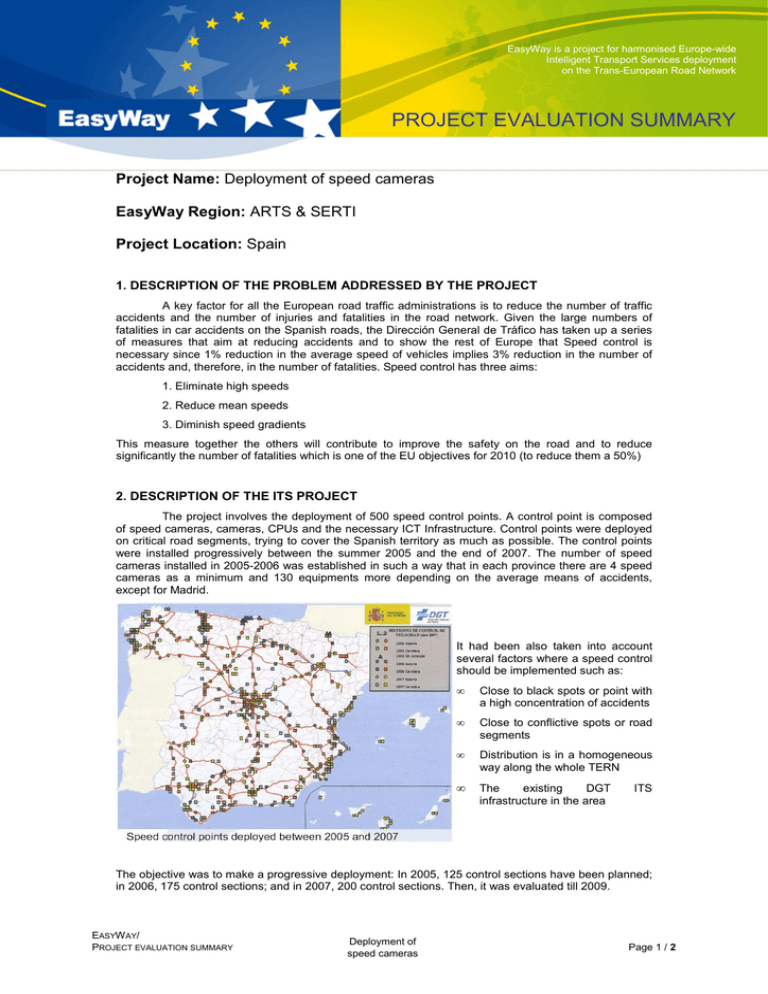Project Evaluation Summary -Speed enforcement_FOSI
advertisement

EasyWay is a project for harmonised Europe-wide Intelligent Transport Services deployment on the Trans-European Road Network PROJECT EVALUATION SUMMARY Project Name: Deployment of speed cameras EasyWay Region: ARTS & SERTI Project Location: Spain 1. DESCRIPTION OF THE PROBLEM ADDRESSED BY THE PROJECT A key factor for all the European road traffic administrations is to reduce the number of traffic accidents and the number of injuries and fatalities in the road network. Given the large numbers of fatalities in car accidents on the Spanish roads, the Dirección General de Tráfico has taken up a series of measures that aim at reducing accidents and to show the rest of Europe that Speed control is necessary since 1% reduction in the average speed of vehicles implies 3% reduction in the number of accidents and, therefore, in the number of fatalities. Speed control has three aims: 1. Eliminate high speeds 2. Reduce mean speeds 3. Diminish speed gradients This measure together the others will contribute to improve the safety on the road and to reduce significantly the number of fatalities which is one of the EU objectives for 2010 (to reduce them a 50%) 2. DESCRIPTION OF THE ITS PROJECT The project involves the deployment of 500 speed control points. A control point is composed of speed cameras, cameras, CPUs and the necessary ICT Infrastructure. Control points were deployed on critical road segments, trying to cover the Spanish territory as much as possible. The control points were installed progressively between the summer 2005 and the end of 2007. The number of speed cameras installed in 2005-2006 was established in such a way that in each province there are 4 speed cameras as a minimum and 130 equipments more depending on the average means of accidents, except for Madrid. It had been also taken into account several factors where a speed control should be implemented such as: • Close to black spots or point with a high concentration of accidents • Close to conflictive spots or road segments • Distribution is in a homogeneous way along the whole TERN • The existing DGT infrastructure in the area ITS The objective was to make a progressive deployment: In 2005, 125 control sections have been planned; in 2006, 175 control sections; and in 2007, 200 control sections. Then, it was evaluated till 2009. EASYW AY/ PROJECT EVALUATION SUMMARY Deployment of speed cameras Page 1 / 2 EasyWay is a project for harmonised Europe-wide Intelligent Transport Services deployment on the Trans-European Road Network PROJECT EVALUATION SUMMARY 3. FOR PROJECTS TO BE IMPLEMENTED - EVALUATION PLANNED The study is post-implementation. The material that is used in the project consists of information gathered from cinemometres. The objectives are to reduce high speeds, mean speeds and speed gradients. 4. FOR IMPLEMENTED PROJECTS – RESULTS The main indicator in the evaluation is the average speed of vehicles at the control points from the summer period 2000 until summer of 2009. The results of the evaluation indicate that the objectives have been met: 1. There has been a clear decrease in the average speed during this period. 2. There have been fewer high speeds being detected and clear decrease in speed gradients. 3. The number of fatalities has been reduced by 7,5 less per day from 2003 till now. Evolution of traffic accidents in the 10 year summer period During 2001-2009 period, the number of fatalities over road during summer season has decreased around 55% therefore, summer 2009 has achieved the UE objective (reduce fatalities around 50%). This milestone comes one year before the EU recommendation. 5. EUROPEAN DIMENSION: LIKELY TRANSFERABILITY OF THE RESULTS Decrease of average speeds, high speeds, speed gradients and number of fatalities can also be obtained on other road stretches if speed cameras are installed. When other control measures are implemented, such as a penalty points system, road education, campaigns, changes in the Penal Code that regards as offences certain driving behaviours, drivers are likely to change their way of driving. The project is totally applicable to the rest of the TERN with a clear problem in mind: what to do with the non Spanish drivers? A European legislation on traffic enforcement it is necessary! Initially Spain and France (and other European countries) have started to exchange traffic fines but the crossborder enforcement seems still far away. EASYW AY/ PROJECT EVALUATION SUMMARY Deployment of speed cameras Page 2 / 2



